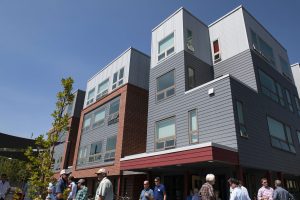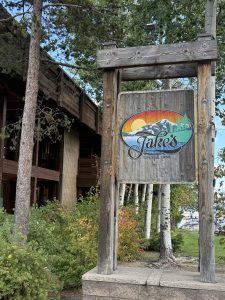Mountain towns weigh in on housing (Part 1)
LAKE TAHOE, Calif./Nev. – The unique challenges of creating and maintaining housing in Tahoe have been the focus of the Tribune’s housing series. Now, the Tribune takes a look at other mountain communities: their challenges, triumphs and lessons they’ve learned.
The Tribune spoke with housing managers and planning employees from Ketchum, Idaho; Aspen and Vail, Colorado; Jackson and Teton County, Wyoming; Hood River, Oregon; and Mammoth Lakes, California. While these communities span across the states, they have similar problems with location, tourism and funding, as well as their own residents’ thoughts on housing development.
Location challenges
While the mountains, lakes and rivers of these rural areas are beautiful, they pose a challenge for developing housing. Limited land makes it harder to build for increasing populations, especially when surrounded by public lands or protected sites.
The city of Hood River’s planning director, Dustin Nilsen, also contends with a bi-state compact with Washington for the Columbia River Gorge. Unlike the California Excess Sites program that enabled Sugar Pine Village and Pacific Crest Commons, Nilsen says that acquisitions into the scenic areas would require an act of Congress, as well as local approval. “I like the idea, but making that choice might not materialize and wouldn’t be the right choice in the immediate future.”
Instead, many mountain communities have opted for density over sprawl. Like with Tahoe, this typically means lifting height restriction and zoning for more multi-family units over single-family homes. “We’re trying to make efficient, more compact development choices than the rural past of this place,” said Nilsen.
Zoning helps promote specific kinds of development, sometimes making ordinances more expansive to allow for increased height or bonus units—something Tahoe is doing with area plans and the Tahoe Regional Planning Agency’s (TRPA) Phase 2 and Phase 3 changes.
Rachael Richards, mayor of Aspen, said that changes in codes to enable more density have been a big focus for them. “We’ve had significant groundwork in our codes… and some of it’s been baked into our land use codes for the last 30 years,” she said.
Major changes in these zoning overlays, including incentives for affordable housing, have made it possible to continue building affordable housing.
Richards says she herself lives in deed-restricted, affordable housing. The ownership of affordable housing was something the county negotiated hard for, and continues to utilize.
Aspen is also in the practice of land banking—a process of aggregating parcels for future development. Land banking has been a long practice in the United States to prevent vacant and blighted properties. Richards says they have been identifying the capacity, transit, water and sewer lines on these parcels in order to best decide what they can be used for.
But with land sometimes hard to come by, getting creative with parcels is another way to get housing. Carissa Connelly, housing director of city of Ketchum, said they are acquiring or researching unusual parcels that are often in between different areas, seeing if they would be appropriate for different projects—which she called “scattered site development.”
Vail, Colorado has also sought to utilize their parcels for housing, and Jason Dietz, director of housing in Vail, said they’ve “taken a hard look at their code and zoning” to make different sites work.
Southbase, a 258-unit project that is one of their most recent additions to housing, used to be part of the town open space—but they converted it through public and private ownership. Dietz says they even purchased part of the land from the Colorado Department of Transportation, who had jurisdiction on some of the site.
Dietz used to work in Summit County, Colorado, where he partnered with the White River National Forest to lease land for affordable housing—the first lease of its kind in the U.S. which is similar to California’s excess sites executive order.
April Norton, affordable housing director in Jackson and Teton County, says mixed-use housing has helped to make it possible to build in the limited lands. USFS and the local community land trusts are partnering on making some of the forest service land on the edge of town available for housing.
Norton says that monitoring their inventory has been invaluable, as it helps them find appropriate parcels that they could consider for housing and public/private partnerships.
Mammoth Lakes also went through this process to acquire The Parcel in 2018, two vacant parcels near the downtown and residential zoning areas. The parcels historically had been involved in land exchanges with the nearby U.S. Forest Service land, but was bought by the town in order to ensure affordable housing would be built there.
Marcus Sproll, housing director of Mammoth Lakes, identified that land restrictions were a major challenge to address with regards to housing.
But finding support for building in these areas can be difficult. People who live in these regions often moved to the area for the natural landscape, and many, like Tahoe residents, care about the environment. Dietz spoke to how the Southbase project came about after a different site was rejected for the potential environmental impacts, so making these work is often a balance of finding space and ensuring it doesn’t overly impact the land.
Tourism challenges
All of these places are tourist destinations—and whether it’s year-round or just for the ski season, it impacts the way that residents and tourists interact. Increased visits means increased need for services and more people to work those jobs, which may not pay enough to live there.
Like Tahoe, these places hire seasonal workers who need places to stay during the busiest times of the year. That seasonality affects the market, but does put the onus on large-scale employers to house them locally.
Connelly says Ketchum is not necessarily the ski center, but they still get plenty of people. “Ketchum is the retail hub—if people want to go out for nightlife or restaurants, they come here,” she said. But with strongly seasonal flow of work, it means it can be challenging for year-round residents to pay market rates.
Additionally, these places are extremely desirable to live in for second or even third homeowners. “There’s the joke that if you’re here, you either work three jobs or own three homes,” said Connelly. “The market caters to households moving in—people who can pay $260,000 a year versus $80,000.”
It’s the same in other mountain communities as well. “Sometimes, even nurse practitioners, engineers and new doctors can’t afford to live here,” said Nilsen.
Plenty of these places also have short-term rentals (STRs) that, along with speculative buying and other vacancies throughout the year, impact housing. But being thoughtful about STRs can alleviate the effects. For example, Nilsen said Hood River allows STRs in residential zones, but the owners must have it be their primary residence.
In Aspen, the STR limits were set after grandfathering previous owners in, then imposing a cap. “Oddly enough, STRs affect long-term rental values,” said Richards, referencing the impact on county assessors and property taxes for the surrounding homes. Residents of Aspen automatically get a six-month pass for STRs with a lower tax rate than those who are out of town—and those taxes go primarily to funding housing as well as the city services.
The state also has an STR excise tax of 6%, which Dietz said has generated $7 million in funds for housing in Vail.
Colorado, which many places look to as a model for affordable housing, is also looking into a “vacancy” or “empty house” tax this upcoming winter. The Colorado Association of Ski Towns notes that there is some interest and will be exploring if it’s feasible and desired by resort communities.
Housing preservation is a major part of making sure that these places stay affordable for locals. Nilsen says in Hood River they are looking to preservation because the city “doesn’t have building new housing in its scheme.”
Richards says many of the long-time residents of Aspen live in affordable housing, where the valley raised $16 million to put a down payment to preserve two mobile home parks, which Richards said was a major aspect of their inventory. They also buy down free-market units, though Richards says it is “extremely expensive as a no-growth model.”
Norton says that historical and workforce housing preservation is a major part of their housing toolbox. “We probably can’t build our way out of the housing challenges here, so we have a revolving fund to purchase homes for rent,” she said. Later, they can sell the home with a deed restriction stipulating the income and mortgage payments, and those funds pour back into allowing them to purchase more homes.
Since 2022 in Ketchum, they require deed restriction for housing or ground leases that last at least 65 years. Idaho doesn’t allow restrictions in perpetuity, but Connelly says they can re-record them to keep them ongoing. They are also purchasing existing buildings to maintain affordability, trying to utilize the places they have and preserve below-market rates. Connelly emphasized that just because some homes are smaller and older, they’re not necessarily more affordable.
Vail’s InDEED program aimed to purchase deed restrictions for 1000 existing properties by 2027. While Dietz said the program has seen success, it has slowed in the last three years due to the costs of housing and homeowners’ associations, along with costs of deferred maintenance and rising insurance prices.
Editor’s note: This article will continue in a second part in the Friday, October 17 edition of Tahoe Daily Tribune.
Eli Ramos is a reporter for Tahoe Daily Tribune. They are part of the 2024–26 cohort of California Local News Fellows through UC Berkeley.
Support Local Journalism


Support Local Journalism
Readers around Lake Tahoe, Truckee, and beyond make the Sierra Sun's work possible. Your financial contribution supports our efforts to deliver quality, locally relevant journalism.
Now more than ever, your support is critical to help us keep our community informed about the evolving coronavirus pandemic and the impact it is having locally. Every contribution, however large or small, will make a difference.
Your donation will help us continue to cover COVID-19 and our other vital local news.










